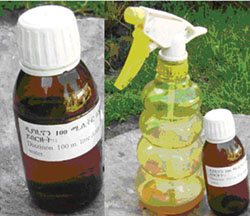2.2.3 Chemical hazards
Chemical hazards are present when a person is exposed to a harmful chemical at home or at work. The chemicals can be in the form of gases, solids or liquids. Exposure to chemicals could cause acute health effects (an immediate or rapid onset) if taken in large quantities in a single dose; and chronic health effects (long-term effects on health) if taken in small doses over an extended time. Detergents (powdered soap, bleaching powder), drugs (veterinary and human) and pesticides (DDT, malathion, diazinon, zinc phosphide, warfarin) are chemical hazards that are commonly found in rural households (Figure 2.3). Farmers, young children (under 5 years) and household animals are vulnerable to chemical exposure, but it is always possible that anyone might come into contact with the chemical during preparation, spraying, use or storage. A person is exposed to chemicals through various ways: through inhaling the vapours, gases or dusts; through skin contact with solvents, acids and alkalis; and through ingestion of unknown chemicals with food and water.

Incomplete burning of fuel releases carbon monoxide (CO) which is a chemical hazard. When breathed in, CO binds to the haemoglobin in our blood, reducing the uptake of oxygen; the cells of the body then suffer because they are not getting enough oxygen. This can result in severe sickness and even death.
2.2.2 Biological hazards
